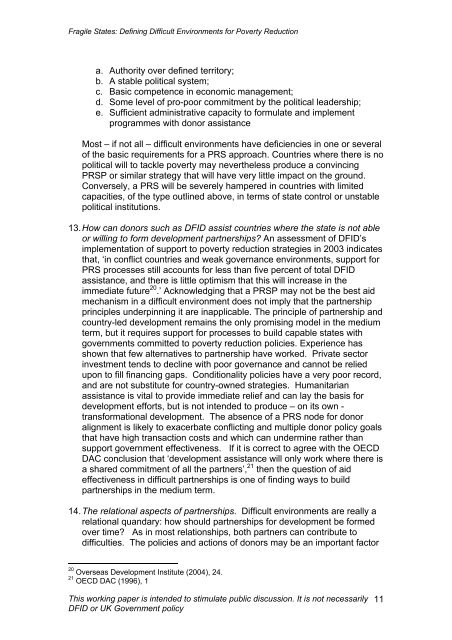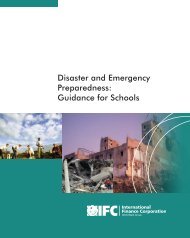Fragile States: Defining Difficult Environments for Poverty ... - INEE
Fragile States: Defining Difficult Environments for Poverty ... - INEE
Fragile States: Defining Difficult Environments for Poverty ... - INEE
Create successful ePaper yourself
Turn your PDF publications into a flip-book with our unique Google optimized e-Paper software.
<strong>Fragile</strong> <strong>States</strong>: <strong>Defining</strong> <strong>Difficult</strong> <strong>Environments</strong> <strong>for</strong> <strong>Poverty</strong> Reductiona. Authority over defined territory;b. A stable political system;c. Basic competence in economic management;d. Some level of pro-poor commitment by the political leadership;e. Sufficient administrative capacity to <strong>for</strong>mulate and implementprogrammes with donor assistanceMost – if not all – difficult environments have deficiencies in one or severalof the basic requirements <strong>for</strong> a PRS approach. Countries where there is nopolitical will to tackle poverty may nevertheless produce a convincingPRSP or similar strategy that will have very little impact on the ground.Conversely, a PRS will be severely hampered in countries with limitedcapacities, of the type outlined above, in terms of state control or unstablepolitical institutions.13. How can donors such as DFID assist countries where the state is not ableor willing to <strong>for</strong>m development partnerships? An assessment of DFID’simplementation of support to poverty reduction strategies in 2003 indicatesthat, ‘in conflict countries and weak governance environments, support <strong>for</strong>PRS processes still accounts <strong>for</strong> less than five percent of total DFIDassistance, and there is little optimism that this will increase in theimmediate future 20 .’ Acknowledging that a PRSP may not be the best aidmechanism in a difficult environment does not imply that the partnershipprinciples underpinning it are inapplicable. The principle of partnership andcountry-led development remains the only promising model in the mediumterm, but it requires support <strong>for</strong> processes to build capable states withgovernments committed to poverty reduction policies. Experience hasshown that few alternatives to partnership have worked. Private sectorinvestment tends to decline with poor governance and cannot be reliedupon to fill financing gaps. Conditionality policies have a very poor record,and are not substitute <strong>for</strong> country-owned strategies. Humanitarianassistance is vital to provide immediate relief and can lay the basis <strong>for</strong>development ef<strong>for</strong>ts, but is not intended to produce – on its own -trans<strong>for</strong>mational development. The absence of a PRS node <strong>for</strong> donoralignment is likely to exacerbate conflicting and multiple donor policy goalsthat have high transaction costs and which can undermine rather thansupport government effectiveness. If it is correct to agree with the OECDDAC conclusion that ‘development assistance will only work where there isa shared commitment of all the partners’, 21 then the question of aideffectiveness in difficult partnerships is one of finding ways to buildpartnerships in the medium term.14. The relational aspects of partnerships. <strong>Difficult</strong> environments are really arelational quandary: how should partnerships <strong>for</strong> development be <strong>for</strong>medover time? As in most relationships, both partners can contribute todifficulties. The policies and actions of donors may be an important factor20 Overseas Development Institute (2004), 24.21 OECD DAC (1996), 1This working paper is intended to stimulate public discussion. It is not necessarilyDFID or UK Government policy11
















